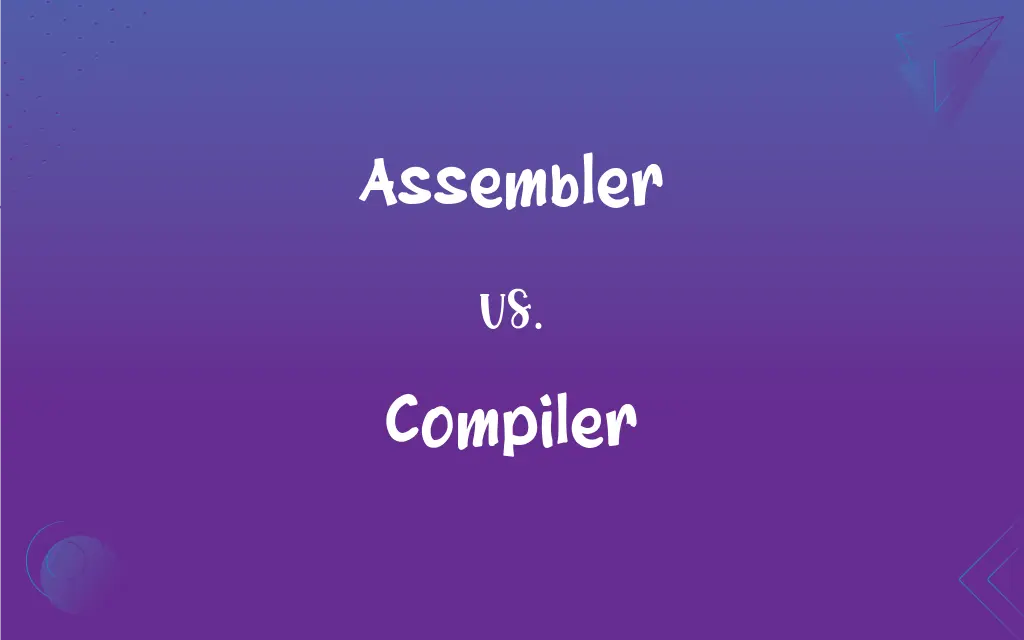Assembler vs. Compiler: What's the Difference?
Edited by Aimie Carlson || By Harlon Moss || Updated on October 4, 2023
An assembler translates assembly language into machine code, while a compiler translates high-level programming languages into machine code or an intermediate code.

Key Differences
An assembler is specifically designed to convert assembly language, a low-level programming language, into machine code. This machine code can then be executed directly by a computer's hardware. Conversely, a compiler works with high-level programming languages, translating them into machine code or sometimes into an intermediate representation.
The primary purpose of an assembler is to transform mnemonic operation codes and symbolic labels into their numeric equivalents, facilitating the computer's ability to understand and execute the program. On the other hand, a compiler often performs multiple tasks, including lexical analysis, syntax analysis, and optimization before producing the final code.
While assemblers typically work with one-to-one correspondence between assembly instructions and machine instructions, compilers handle more complex translations. A single line of high-level code in a programming language might translate to multiple machine instructions when compiled.
Assemblers usually provide direct and fine-tuned control over the hardware, given the closeness of assembly language to machine code. In contrast, compilers, dealing with high-level languages, abstract away many hardware specifics, making programming more accessible but potentially less optimized.
The choice between using an assembler and a compiler often depends on the specific requirements of a project. While assemblers offer precise control, compilers provide a more convenient and abstracted approach to software development.
ADVERTISEMENT
Comparison Chart
Input Language
Translates assembly language.
Translates high-level programming languages.
Output
Produces machine code.
Produces machine code or intermediate code.
Level of Abstraction
Low-level, closer to machine language.
High-level, abstracted from machine specifics.
Translation Approach
Typically one-to-one translation.
Can involve complex translations for a single line.
Hardware Control
Provides fine-tuned control over hardware.
Abstracts many hardware specifics.
ADVERTISEMENT
Assembler and Compiler Definitions
Assembler
Assemblers deal with low-level programming languages.
For better hardware control, he turned to an assembler.
Compiler
Compilers perform multiple stages of translation and optimization.
The compiler optimized the loops for better performance.
Assembler
An assembler is a tool that translates assembly language into machine code.
The programmer used an assembler to generate the executable file.
Compiler
A compiler is a program that translates high-level programming languages into machine or intermediate code.
She used a compiler to convert her Java code into bytecode.
Assembler
An assembler provides direct control over computer hardware.
To optimize the routine, the developer used an assembler.
Compiler
A compiler can produce either direct machine code or an intermediate representation.
The C compiler generated machine code for the target platform.
Assembler
Assemblers work with mnemonic operation codes and symbolic labels.
The assembler converted the mnemonics into their numeric counterparts.
Compiler
Compilers make programming more accessible by handling high-level languages.
With the compiler's assistance, she quickly developed the application.
Assembler
Assemblers typically have a one-to-one translation approach.
Each assembly instruction was translated directly by the assembler.
Compiler
Compilers abstract many hardware specifics.
Using a compiler, he didn't have to worry about memory management.
Assembler
One that assembles, as a worker who puts together components of an item being manufactured.
Compiler
One that compiles
A compiler of anthologies.
Assembler
(Computers) A program that produces executable machine code from symbolic assembly language.
Compiler
(Computers) A program that translates another program written in a high-level language into machine language so that it can be executed.
Assembler
A program that reads source code written in assembly language and produces executable machine code, possibly together with information needed by linkers, debuggers and other tools.
Compiler
One who compiles.
A compiler of poetry anthologies
My favourite crossword compiler
FAQs
Can a compiler output something other than machine code?
Yes, some compilers output intermediate code.
Which is closer to machine language, an assembler or compiler?
An assembler, as it deals with assembly language.
What is an assembler?
An assembler translates assembly language into machine code.
Why don't all developers use assemblers if they offer more control?
While assemblers offer control, compilers provide ease and abstraction, which is often more convenient.
What is the input to a compiler?
A high-level programming language.
Are assemblers still relevant in modern software development?
While less common, assemblers are still used in areas like embedded systems or performance-critical tasks.
Why use an assembler instead of a compiler?
An assembler provides more direct and fine-tuned control over hardware.
Can one high-level code line translate to multiple machine instructions?
Yes, especially when processed by a compiler.
Do all compilers work with all programming languages?
No, compilers are usually designed for specific languages.
Are there any similarities between an assembler and compiler?
Both translate human-readable code into machine-readable format.
What might a compiler do beyond just translating code?
Compilers can optimize code, perform syntax and lexical analysis, and more.
Can I write assembly code in a high-level programming environment?
Yes, many high-level languages allow inline assembly for specific tasks.
Can a compiler optimize my code?
Yes, many compilers offer optimization options to enhance performance.
How does an assembler handle errors?
Assemblers can report errors related to unrecognized mnemonics or invalid operands.
Is it necessary to learn assembly language to be a programmer?
No, but understanding assembly can offer insights into how computers work and can be beneficial in certain fields.
What does a compiler do?
A compiler translates high-level programming languages into machine code or an intermediate code.
Is assembly language considered high-level or low-level?
It's considered a low-level language.
Which is more complex, a compiler or an assembler?
Typically, compilers are more complex due to multiple stages of processing.
Can you give an example of a popular compiler?
Yes, the GCC (GNU Compiler Collection) is a widely-used compiler.
How does a compiler handle errors in code?
Compilers can detect and report syntax and some semantic errors during the compilation process.
About Author
Written by
Harlon MossHarlon is a seasoned quality moderator and accomplished content writer for Difference Wiki. An alumnus of the prestigious University of California, he earned his degree in Computer Science. Leveraging his academic background, Harlon brings a meticulous and informed perspective to his work, ensuring content accuracy and excellence.
Edited by
Aimie CarlsonAimie Carlson, holding a master's degree in English literature, is a fervent English language enthusiast. She lends her writing talents to Difference Wiki, a prominent website that specializes in comparisons, offering readers insightful analyses that both captivate and inform.































































